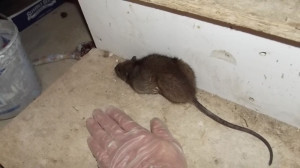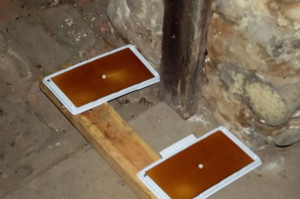The Bait Rats Find Irresistible: Part One
By Chris Williams on July 2, 2014.
Katlyn Graham: Hello, I’m Katlyn Graham here with Tim Chace, a pest control technician and entomologist with Colonial Pest. Welcome, Tim.
Tim Chace: Hi, Katlyn.
Katlyn: How are you?
Tim: I’m doing great today.
Katlyn: Oh, good! Today we’re discussing tips on rat removal in Massachusetts and New Hampshire. Tim, when you are picking a good rat exterminator, what are the tips you would offer?
Tim: First thing, I would use a reputable firm that’s got a reputation. You want to know the person that’s coming out has had some experience in maybe not a fly‑by‑night company, because there’s a lot involved with rats and what they’re up to. I would also pick someone that’s done this before.
There’s a little bit of a learning curve with dealing with rats. They’re very smart animals, evolved over many, many millions of years to be successful. That’s one of the things to take into consideration. You want someone that’s done this before, someone with some experience in different locations, too. The more experience, the better.
If you can get someone that’s got some references, that’s always nice, too. Say if Angie’s List recommended you, that would be a good place to start, because they’ve had some interaction with you and someone at least has liked it or disliked it. That’s a good reference to start with.
You could also ask your neighbors or people who they use for pest control. Usually if they’ve had some experience with rats or rodents, they’ll have known somebody. It’s not that uncommon to have dealt with rodents over the years.
Katlyn: You have certainly dealt with rodents and have lots of experience, so we’ll tap that right now. What are the type of baits that you’ve found are irresistible for rats?
Tim: Rats are interesting little critters. They’re what we call omnivores. They’ll eat plant materials. They’ll eat animal materials, prepared food, raw food, nuts, live insects, whatever they can find.
What you’re looking for in a successful bait placement is going to be something that’s both attractive to the rat, and I’d say a little bit long‑lived so that you can put it in a place so it’s not going to evaporate or vanish, or change over time.
Two of the chief baits that I’m using right now would be ‑‑ we don’t want to use the names of the products ‑‑ a wax block bait. You’ve got some baits that have a seed matrix in it. The active ingredient is locked in with a waxy structure. These baits would be placed in a bait station.
There are several different kinds of these baits. There’s one with a seed attractant or bait mixture. The animal would come and feel like feeding on seeds, smell the seeds inside there, and then consume the poison. There are several other wax block type baits that have all food‑grade ingredients. They smell very pleasing.
This wax material is able to keep the bait a little bit more protected in environments that are a little bit moist. You’ve got your bait station outside by the side of the house. That would probably be my preferred bait for that.
There’s also a class of baits that have come out recently that we refer to as soft baits. These are baits that are in a little paper package. There’s no wax to protect the bait. It looks almost like a little piece of gum. Care and placement considerations must be considered at all times.
Whenever we’re using these baits, we’re following the implicit manufacturer’s directions and the state directives to make sure that these baits are placed away from children and pets in a location that will in fact give us the results we need. When we’re talking about rat control, as well as choosing the right type of bait, but also where you place it and how you place it is one of the most important considerations.
Katlyn: Where do you place it?
Tim: Wow, that’s a great question. Again, we’re thinking about areas that are away from children and pets, if possible. There are devices that are made to introduce bait, let’s say, next to a public space or a playground. Obviously, you’re going to have children and pets.
There are devices that we call bait stations. They’re child and pet proof. Heavy plastic, resin‑molded construction that are in some cases locked or heavily secured. Tied down in place so they can’t be picked up or placed under secure objects. There are these devices that resemble rocks so they’re not as exciting or interesting to look at. They fit into the landscaping features.
The main thing that these devices share is their ability to protect the bait from the kids and pets. The bait is literally locked inside the bait station.
Your bait station placement. You want to put it in the areas that the rat is going to be encountering in his normal foraging activities. Typically placed at burrows, between the rat and the food source. Instead of putting your bait placement next to the dumpster, you might put it several feet away from the dumpster or adjacent to the structure so you’re not competing directly with this other food source. Those are considerations that you have when you’re using bait placements.
The soft baits are much more difficulty secured inside the exterior bait station. If there’s any chance of kids and pets, that would be not a good choice, because the way these things are constructed, it’s a lot more fragile than the actual waxy bait blocks.
That being said, they’re excellent for an interior wall void placement or interior bait stations that you can secure from kids and pets. Just make sure no one goes down there.
Rats will consume these almost immediately. The lethal time that it takes the bait is usually three to five days.
Some of these baits are single‑feeding baits, so the rat would just have to come to it one time and that would be his last meal.
Some of these baits allow the rat to eat a couple times before he dies, depending on which bait it is exactly, and what we’re trying to accomplish.
Because rats are so smart, we try to very diligently protect our baits from human contamination. The main one is just the human scent from your own fingers and hands. We’ll handle all that material with gloves on and during the placement of the bait.
Smoking or chemicals that might contact the bait or the bait station could present an aversion to rats.
Rats are very interesting creatures. They have what’s called “new object shyness.” An animal that’s used to going around its territory has memorized that area, so even without its eyes it can run from the little opening it comes out to, around the chimney, through the boxes, and back into the other hole without even thinking about. It’s got a muscle memory of its territory.
Katlyn: Interesting.
Tim: They’re also thigmotactic. They like to be close to cracks and have at least part of their body touching something, and one of their whiskers. Their whiskers are amazing things.
Rat whiskers, like dog and cat whiskers, can move forward and backwards and sense the environment. It’s an articulated feeler, if you will.
As he’s whipping along, if he comes to something that he’s not recognized, he might jump over it, or turn back, the first time. The second time he’s seen it, he says, “Oh, I saw this before,” and he’ll go and investigate the bait. It takes them a couple of encounters to even come up to a new thing.
Where you put those, you want him to be able to get used to it as quickly as possible, and then he’ll get in and maybe feed on the bait.
There are lots of considerations when you think about where to place the bait and what exact bait you’re using.
Katlyn: There sure are. You mentioned new object shyness? Is that what you called it?
Tim: Yeah.
Katlyn: Is there anything else that rats are afraid of?
Tim: Absolutely, yeah. They do react to predators and motion in their environment, but if it doesn’t pose itself as a threat, and the rat’s very comfortable, you could have a rat just sitting in the basement looking at you.
Rats are very, very intelligent. Let’s say that you’re a homeowner and you’ve noticed that there are rat droppings around and the faint smell of urine, and, “Gee, that’s a squirrel jumping around in the night.” Squirrels don’t jump at night, so that night squirrel is a rat.
You’ve noticed some damage in the corner and some rat droppings, and you scurry off to the hardware store, and get your peanut butter out. You take some peanut butter on that and you place it in the middle of the room, and you realize the next day that the peanut butter is gone, and the rat trap has been set off, but it’s empty.
That rat has maybe come in contact with the rat trap but not set it off. He will never come near a rat trap again. He’s now learned that that rat trap is dangerous.
If a rat gets on a glue board and successfully escapes, he’ll never go on a glue board again. Sometimes you’ll find one with fur on it or something, and he’s escaped, so he’ll never touch a glue board.
If you’ve got a rat that’s being heavily trapped in an area, he might not go to the bait station, because he could associate that the timing of these things coming in together as one.
Katlyn: Very intelligent that he can put that together.
Tim: Yeah, so one of the things we ask homeowners is at the first sign of a rodent infestation to call a professional, because if the trapping is done properly, I can have a heck of an impact in the first couple of hours that night.
If I can learn where the rat was moving around freely, I can set up traps that will kill most of the adult rats that night. As well as the bait placement.
If the traps kill a lot of them that night, they won’t be shy about the bait placements because they’re gone, so the next rats will come out and enjoy the baits themselves.
You also want to put bait stations in places that aren’t near the traps so they’re completely unrelated. So sometimes a whole bunch of stuff shows up at once.
It’s like, “Hey, all this was not here yesterday.” That can be an interesting fiasco.
I did a job over the winter where the rat was actually eating the plastic pipelines in Portsmouth. When I arrived, there were over 150 traps, glue traps and bait placements around this basement.
The rat had literally learned that was a bad place to go and was now living in the upstairs walls, chewing these water lines. So soft bait was actually placed into the wall voids.
Within a week, the little guy was no longer moving. So that’s an example of thinking outside of the box. You’ve got to abandon this strategy downstairs because the rat is done with that.
In Part Two, Tim Chace will have tips for Rat Removal in Massachusetts and New Hampshire!

